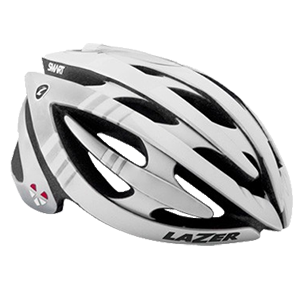LifeBEAM Smart Helmet
1. Easy to use.
2. Good battery life
Cons:
1. Lacks proper ventilation system.
2. A bit expensive.
 The LifeBEAM Smart Helmet has been around for more than a year now. This is the first ever ANT+ enabled cycling helmet with a Heart Rate (HR) sensor. The helmet will broadcast your heart rate directly to compatible devices like smartphones or GPS bike computers. The helmet package looks like the regular helmet boxes except the bright pulse-like graphic on the front. You will also notice the ANT+ symbol on the front, which indicates this is an ANT+ supported device. The package includes the helmet, a micro-USB cable, a handy carrying bag, adjustment pads and some paper manuals. However, the single most important thing from the manuals is to know that the helmet is turned on when the blue LED is on, and that’s it.
The LifeBEAM Smart Helmet has been around for more than a year now. This is the first ever ANT+ enabled cycling helmet with a Heart Rate (HR) sensor. The helmet will broadcast your heart rate directly to compatible devices like smartphones or GPS bike computers. The helmet package looks like the regular helmet boxes except the bright pulse-like graphic on the front. You will also notice the ANT+ symbol on the front, which indicates this is an ANT+ supported device. The package includes the helmet, a micro-USB cable, a handy carrying bag, adjustment pads and some paper manuals. However, the single most important thing from the manuals is to know that the helmet is turned on when the blue LED is on, and that’s it.
There are a few labels on the inner part of the helmet. The left labels contain basic information about the helmet, nothing special. Including the CPSC safety label, the labels on the right are very important, as most professional races including triathlons won’t let you participate without these labels. The HR sensor is on the front. With a weight of only 315 grams (11 ounces), the helmet is not that heavy.
The helmet is provided with a rechargeable battery. The small USB charging port is on the back, covered by a rubber door. You can plug the micro USB charging cable into any wall charger, car charger or any of the USB ports on your computer. The battery is rated to last 13-15 hours on a single charge. There are some tiny wires inside the helmet that connect the battery with the HR sensor and the communication transmitter. While the electronic setup is firmly attached to the helmet, some users were able to detach it and use it on other helmets. However, that is a task reserved for technically skilled users only. The tiny scrolling knob located on top of the helmet will allow you to tighten the fit, and like any other helmet, the strap is long enough for all kind of cycling needs.
The helmet is controlled by the rear pod. The pod hosts the power button, USB port and the indicator LED light. To turn on the device, simply press and hold the power button for a few seconds. When the blue LED starts glowing and the helmet beeps three times, you will know that the helmet is turned on. When the helmet is on, holding the power button for a few seconds will turn it off. If the helmet is not used for 10 minutes, it will automatically turn off to save power. The HR sensor takes no more than 10 seconds to accurately read the heart rate of the user.
In the area of connectivity, the helmet comes with both ANT+ and Bluetooth 4.0. ANT+ is used in lots of devices including Garmin, Magellan, Suunto and Timex. Therefore, you will be able to connect the helmet to any of these devices, along with any Bluetooth supported device. The helmet does not come with any dedicated app, but rather, it works with most of the popular fitness apps. Your ANT+ device or the smartphone app has to support smart HR profile reception in order to display the heart rate information. When you are using the helmet for the first time, you have to pair it with your device, which is very straightforward.
Though the helmet does not do a lot, it does what it claims. By using this helmet, you will be able to get your heart rate data without using any straps. The sensor is very precise in its calculations. While traditional straps require some moisture to read your heart rate correctly, the helmet does not need anything like that, and it can be especially useful in cold conditions where humidity is low.
A significant weak point of the smart helmet is its poor ventilation system. While the brow pad of the helmet restricts airflow to some parts, the electronic panel blocks the rear ventilation ports. Therefore, LifeBEAM’s smart helmet won’t be an excellent choice for riding in hot weather, humid conditions or during steep climbing sessions. Currently, there are two sizes available for the helmet – Medium and Large. Unfortunately, it is only available in the white-silver color at this time.
Starting with pilots, Special Forces and astronauts as their initial test projects, LifeBEAM gradually expanded into the arena of extreme activities. It invests heavily in the research and development fields. The company’s technologies are used to measure performance with superior quality gear. The main goal of the company is to develop wearable technology which will not only fit into your life, but also significantly improve and enhance your fitness levels. Based in Israel, the company has operation centers in China and USA, and their smart helmet rounds out our list of iReviews 2015 best smart apparel.
Related YouTube videos:
